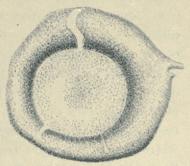
Full resolution (JPEG) - On this page / på denna sida - Contributions to the Biology and Morphology of Spiroptera (Gongylonema) Neoplastica n. sp.

<< prev. page << föreg. sida << >> nästa sida >> next page >>
Below is the raw OCR text
from the above scanned image.
Do you see an error? Proofread the page now!
Här nedan syns maskintolkade texten från faksimilbilden ovan.
Ser du något fel? Korrekturläs sidan nu!
This page has been proofread at least once.
(diff)
(history)
Denna sida har korrekturlästs minst en gång.
(skillnad)
(historik)
The shape of the capsule is somewhat differing according to the various individuals;
most probably this is proportionate partly with the space which is left to the disposal
of the worm during the aet of encysting, partly with the state of contraction of the
surroimding muscles. The circumference generally is nearly circular and somewhat flat-
tened, the capsule being thus lenticular and thickest in the middle. Often, however,
it has a more or less longish shape almost as a somewhat flattened egg.
As a rule the worm if not disturbed will keep rather quiet withiri its capsule,
small slidiiig movements being observed as the spiral is contracted or relaxed; greater
movements no more than changing of place will occur.
When isolated from the surrounding muscular tissue and placed under a cover-
slip in a solution of physiological common salt the larva within its capsule will
show itself most extraordinarily animated, owing to the unusual conditions. It
moves about inside the capsule in a most energetic way, describing with its body now a
spiral, now a figure of eight, the head sometimes in the centre of the capsule, some-
times in the periphery.
 |
| Fig. 3. |
<< prev. page << föreg. sida << >> nästa sida >> next page >>